A STONE QUARRY AND A BUS SHELTER
THE STORY OF THE GLEDHILL FAMILY, OWNERS OF LOWER EDGE QUARRY AND HOW ONE FAMILY MEMBERS CAME TO BUILD A BUS SHELTER
INTRODUCTION
Stone quarrying has been going on in Rastrick and Elland since medieval times and Lower Edge Quarry is still producing high quality York Stone from the Elland Flags outcrop. It was once owned by the Gledhill family and is still known as Gledhill’s Quarry to this day despite being owned by Rand & Asquith since it re-opened in the 1980’s. This is a brief history of the Gledhill’s and how one member of the family came to build a bus shelter at the top of Lower Edge hill.
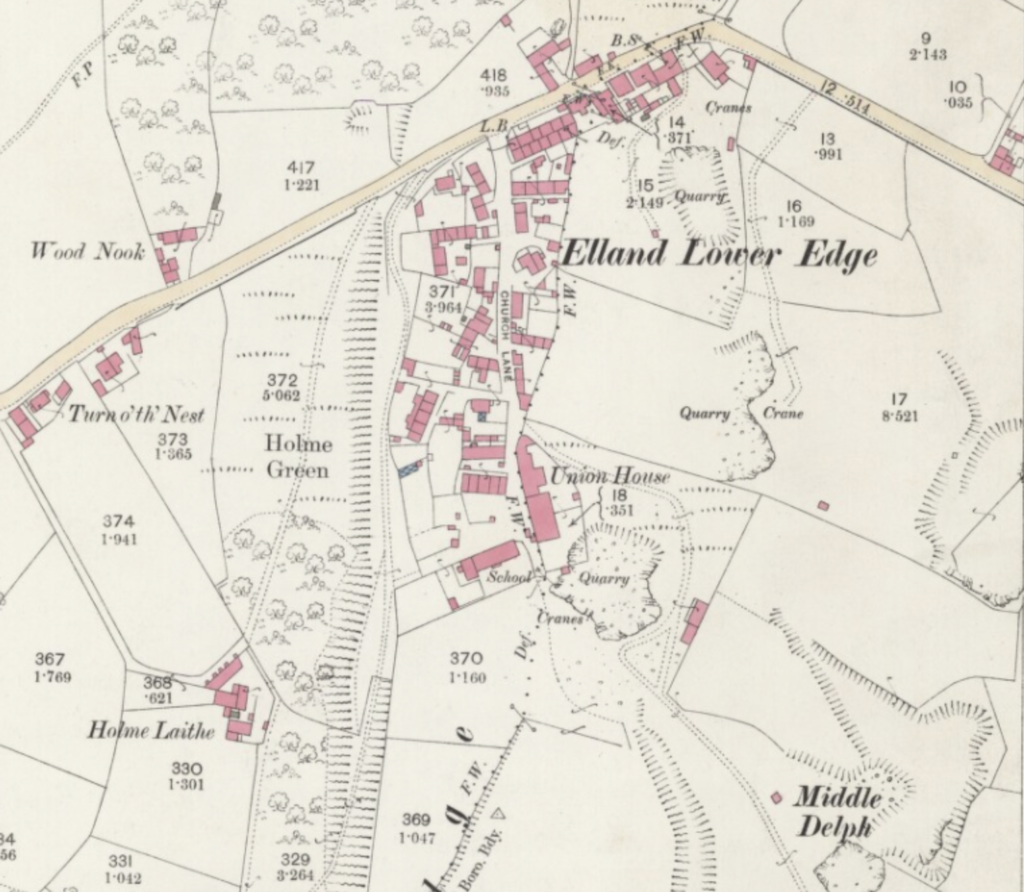
We begin this story at the start of the 1800’s, in the reign of King George III. Ambrose Gledhill was born on the 6th March 1808 and was the son of Joseph & Betty Gledhill, a maltster from Elland. Ambrose married Ann Brook at Halifax, St. John on 8th March 1840.
Their son Samuel Gledhill was born on 13th June 1842 and baptised at Elland St. Mary’s on the 4th August 1850. He was one of at least four children.
When Samuel was just 7 years old, his father passed away leaving his mother, Ann, who was 3 months pregnant at the time, to look after him and his two siblings aged 8 and 4 years old. By the time of the 1851 census, Samuel was working as a factory boy, aged just 8 years old and his sister Elizabeth was a 10 year old factory girl. Their wages wouldn’t amount to much but were essential to help to feed the family which included 4 year old Joseph and his sister Mary who was aged 10 months. Ann would have probably taken any part-time work that she could find in order to help with the finances and no doubt, the two eldest children would have been left in charge of their younger siblings. The family lived at Long Wall, Elland but Samuel left his job as a factory hand and trained in the local quarries to be a stone mason.
Samuel married Martha Marsden at Elland St. Mary’s on the 16th July 1868 and following their wedding, they went to live next door but one to his mother at Long Wall. The family remained there until 1880 when they moved closer to his workplace in the quarries at Lower Edge where he was working as a mason. Samuel’s move to Lower Edge coincided with technological developments in the quarrying industry. The quarrying industry had mainly been confined to outcrops of stone on hillsides, which, once the overburden (trees, grass, soil etc) had been removed, it was easier to quarry the stone by attacking it horizontally. The new technology meant that shafts could be sunk vertically into the stone and underground tunnels created, going off at various angles from the shaft. Adaptations to the invention of the steam engine meant that steam cranes could haul larger stones, and steam powered pumps could remove excess water and improve ventilation.
Samuel was obviously a man of ambition and did not want to bring up his own children in the abject poverty that he had seen as a young boy and by the time of the 1881 census, he was working as a farmer in a addition to his job as a stone delver. Delving was dangerous work and there were many horrendous accidents in the stone quarries where little regard was given to the lives of the workers. Around this same period, Samuel went into partnership with one of the Normington brothers (believed to be Mark Normington) who had already established quarries on the land between Upper Edge and Lower Edge and in July 1889, the company known as Normington and Gledhill were awarded a contract, along with several other quarry owners from that same area, to provide stone setts for the re-surfacing of Commercial Street, Brighouse and Bridge End, Rastrick.
Samuel and Martha had eight children, an equal number of sons and daughters. He started to lease buildings and land at 36, Church Lane, Lower Edge
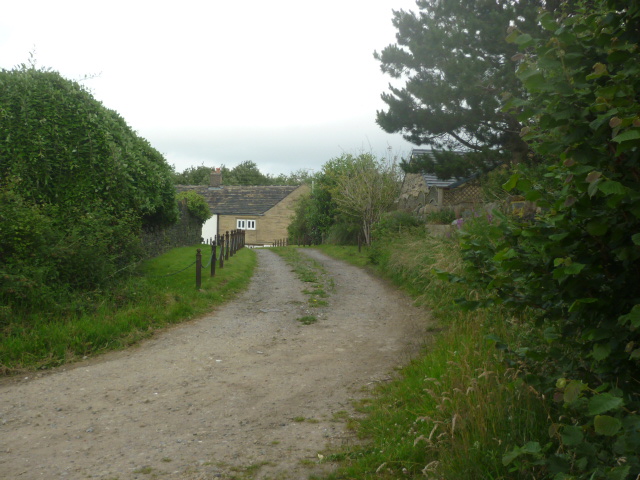
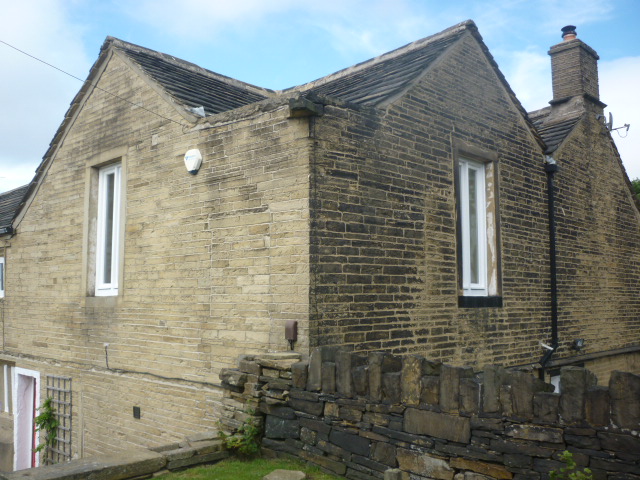
Looking at the photograph above left, behind the bushes on the left is the garden of a very nice modern bungalow but this was previously the location of St. Michael’s Church and Infants School. The school dated back to the 1860’s but the building suffered structural damage in 1944 and the church was closed for two years. It re-opened for a short time before finally closing it’s doors in 1954. The schoolroom remained open and was used by locals for social functions until 1979. It was completely demolished soon after that date.
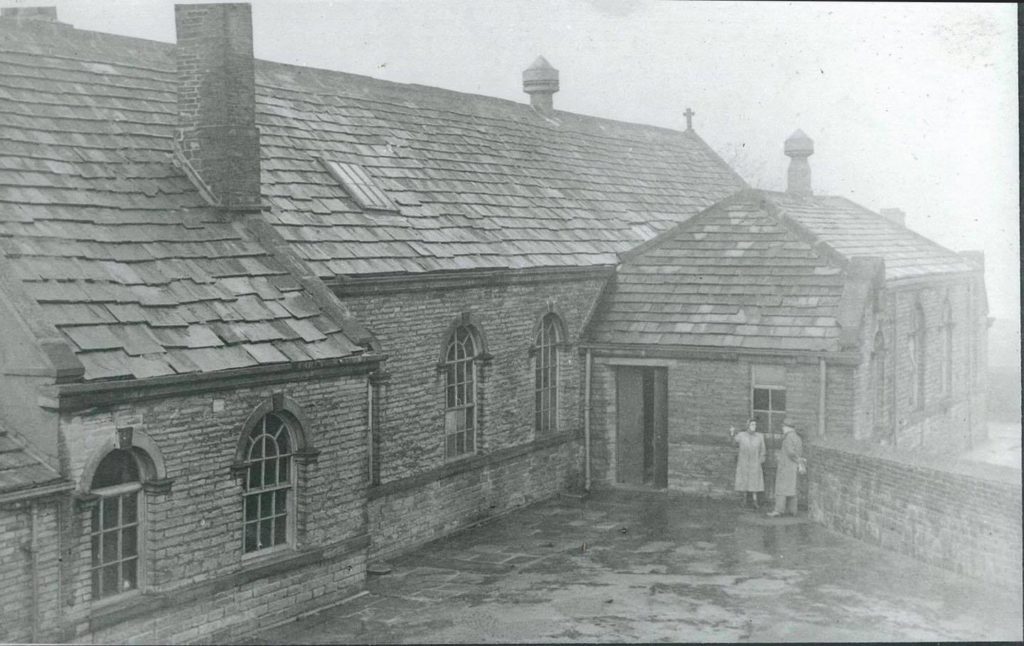
At the end of Church Lane, with on the left, a stone-built shelter of 1955, unfortunately now roofless. It was built by John Jagger Builders and paid for by Mr. Ambrose Gledhill who dedicated it to his two sons, Herbert and John (Jack) whose names are inscribed inside. Straight across the road, the recently re-built “Coach House” and the former Royal Oak public house. This was the home of the Lower Edge Bowling Club many years ago and the pub sported its own crown green. Turn right round the front of the former Co-op shop, now a house appropriately called The Old Co-op. You are now on Lower Edge Road, another former turnpike trust road, under the guardianship of the Brighouse and Elland trust, thought to have been turnpiked about 1740, improved by them in 1814-15. Tolls on this route were abolished in 1868.
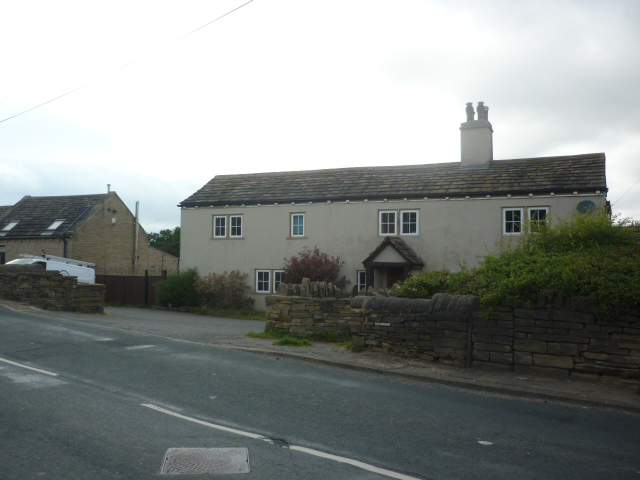

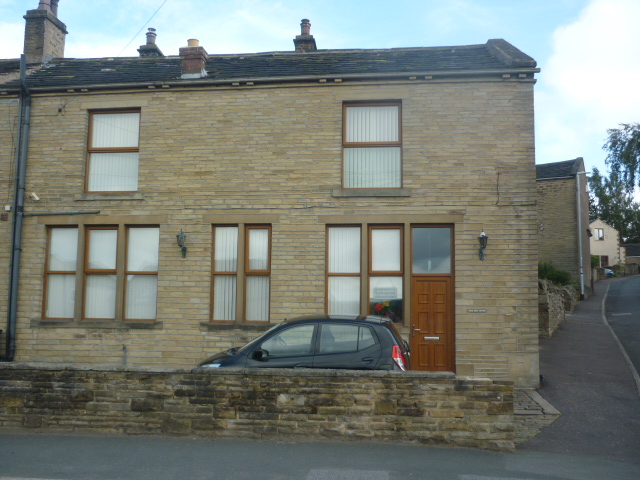
Proceed along Lower Edge Road but when you are outside the last cottages on your right, one of them named Masons Cottage, look across the road and see a stone carved with the letter ‘E’ on one edge and ‘R’ on the other. You have arrived back in Rastrick. In fact, on your side of the road you have been in Rastrick for all except the first row of houses.

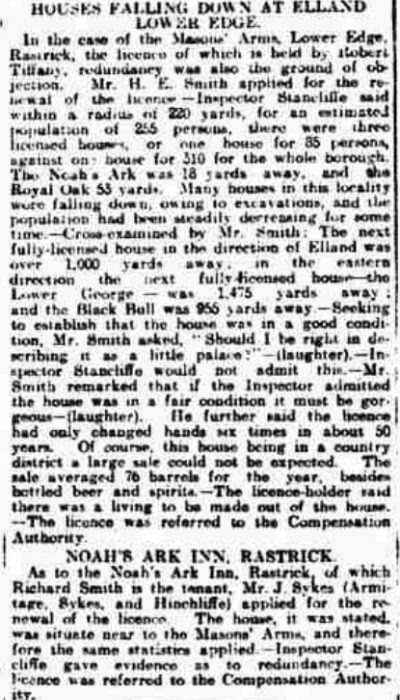
Number 115 Lower Edge Road used to be the Noah’s Ark inn and number 105, Masons Cottage, used to house The Mason’s Arms, both of which closed in 1908, leaving only the Royal Oak open (though that too has now closed). It is perhaps understandable that three public houses in a village the size of Lower Edge was considered to be excessive so, like the Black Bull at Upper Edge, these two became victims of the 1904 Licensing Act.
As you go round the right-hand bend a lane goes off on the other side which leads to Boothroyd. Boothroyd House was re-built about 1850. Being bought from mill-owner Hanson Ormerod by William Smith of Lands House, it was used as an auxilliary military hospital during the Great War, then from 1919 as an orphanage, firstly for girls then for boys too. In 1959 the Smith’s Homes closed and two years later it became a residential school for those with special educational needs, now named The William Henry Smith School. Also off Boothroyd Lane are paths through Strangstry Woods and, now hard to discern, the track which was used to take stone from local quarries down to the Tag Cut canal loading wharf.
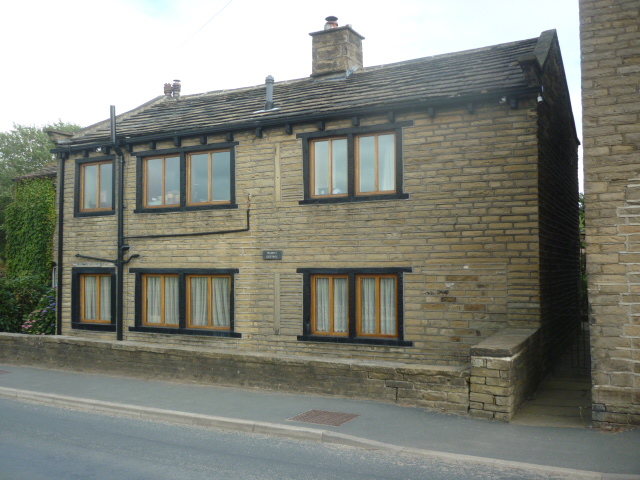
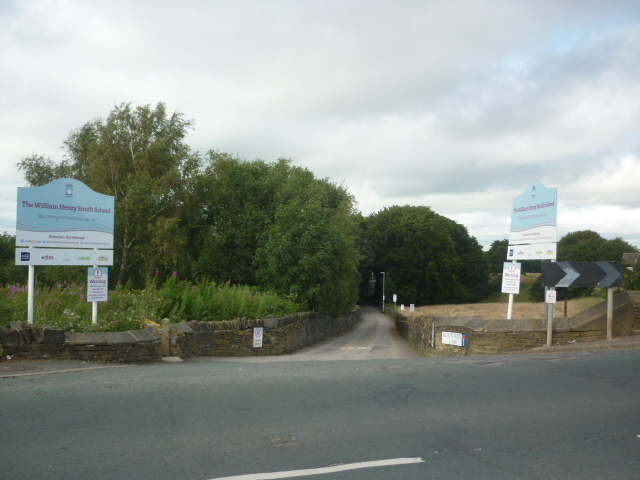
Next on the right is the entrance to quarries, now worked by Brighouse-based firm, Rand & Asquith. Known as Gledhill’s Quarry, Elland Lower Edge Quarries or Elland Edge Quarries, this sandstone quarry is thought to have been mined since the middle ages and is now the last working quarry in our immediate area. As at several sites in Rastrick, the stone was at one time mined, rather than quarried, and the present operation has uncovered mined galleries and shafts at a depth of about seventy feet. For Health & Safety reasons, the public are not allowed onto the quarry site but it is possible to view photographs at https://www.examinerlive.co.uk/news/west-yorkshire-news/gallery/mine-hidden-100-years-discovered-10271611
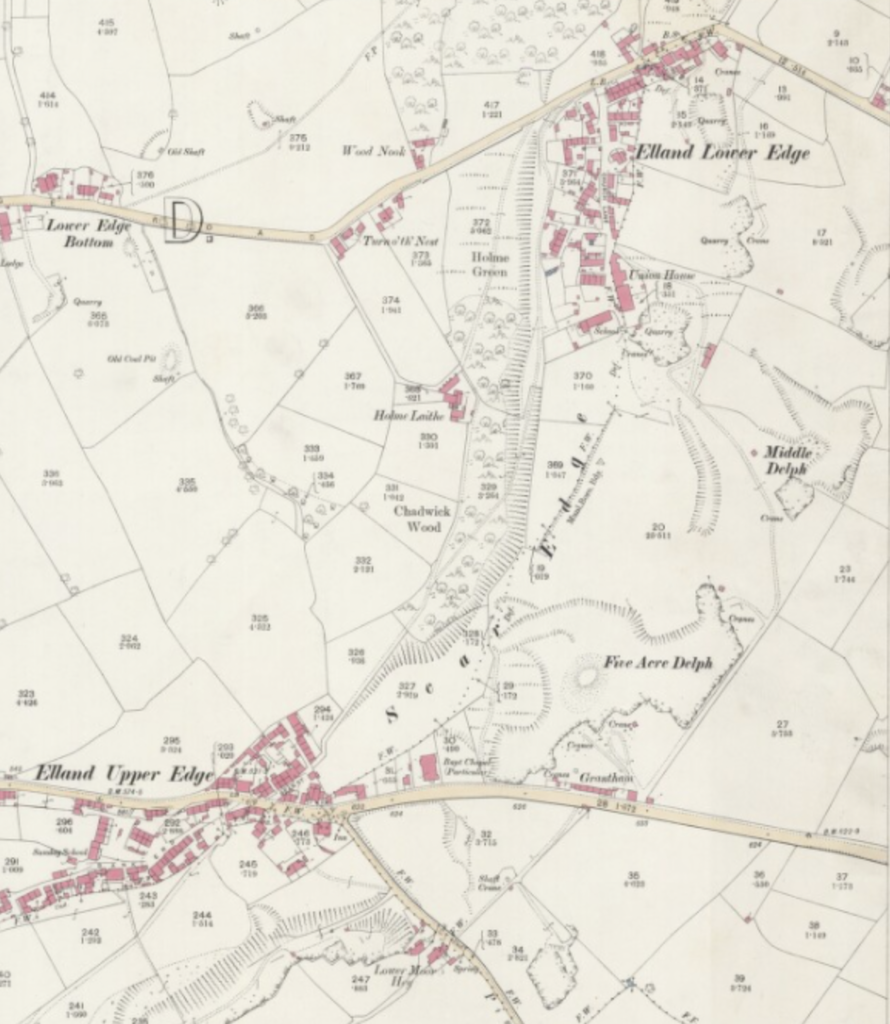
This 1893 map shows the whole area between Lower Edge Road and Dewsbury Road to have been riddled with quarries. The stone from these is found all over the world.
On the left hand side of the road is the top edge of the Field Lane housing estate. In 1951 Brighouse Borough council announced plans to build six hundred houses on what was essentially a green field site. The first phase of the estate was completed in 1953-62 with a second phase in 1968-72 but further houses have been added more recently, including those in Gargrave Close which back on to Lower Edge Road. Ownership is now either by housing associations or privately.
The entrance to the estate from Lower Edge Road is by way of Nunnery Lane, the next road to the left. This used to lead to Nunnery Farm and, before Boothroyd Lane was built, on to Boothroyd. The 1854 map seems to say Nunnery Gate at the junction, which might suggest there was a toll bar here at that time but probably is simply derived from the Norse word for a street, gata. Nunnery Farm was derelict for some time then demolished for the building of the council estate, as were also houses at that junction.
Next on the right is a terrace of nine houses (pictured below) which comprises of three similar blocks of three, the middle of which has a date-stone clearly inscribed, Highbury Place 1838.

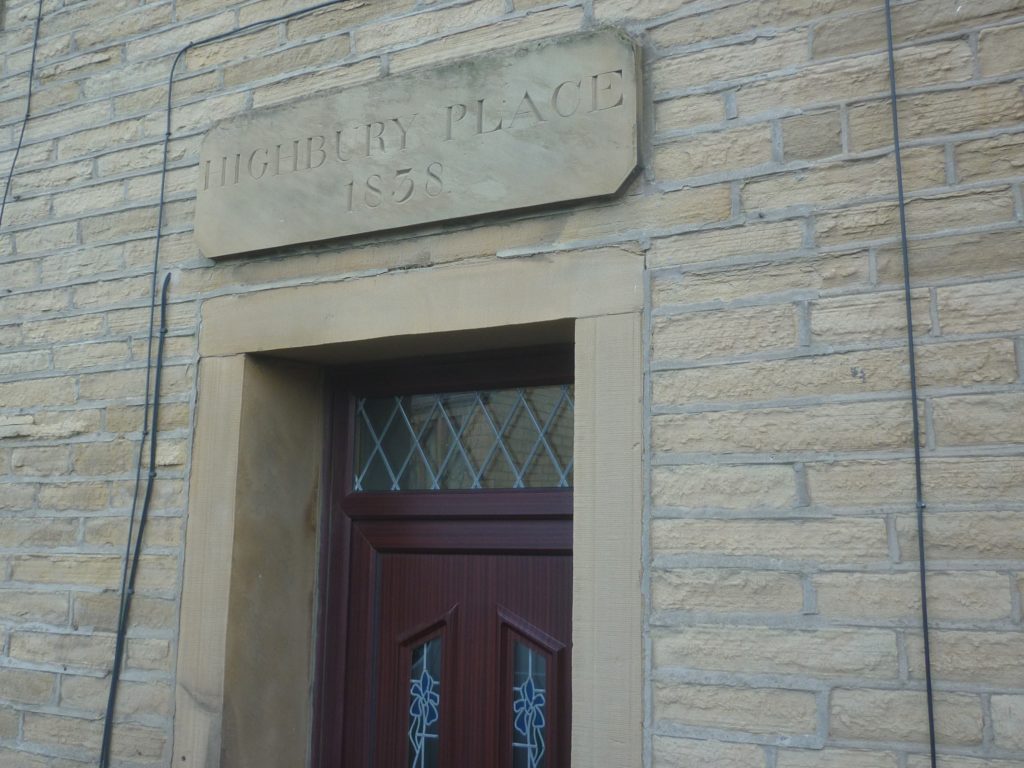
The considerably larger detached house which follows is Highbury House. This was once the home of Robert Thornton JP (1836-1918). He had been born at Nunnery. Jointly with his cousin, he was a cotton spinning mill-owner in Elland but he is probably best remembered as the mayor of Brighouse and for having Thornton Square, Brighouse, named after him as well as the Brighouse Town Hall clock (‘Owd Bob’) which was his gift to the town. As mayor, he was said to have been, at the age of 79, the oldest mayor in England. He lived at Highbury House from around the turn of the century until his death.
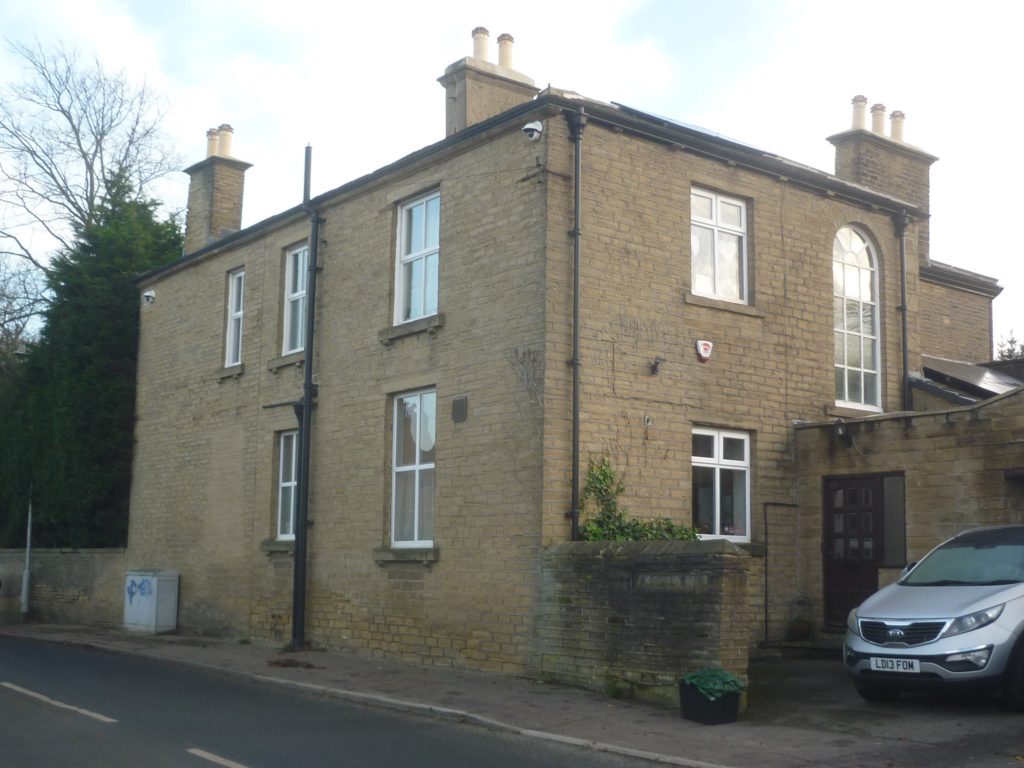
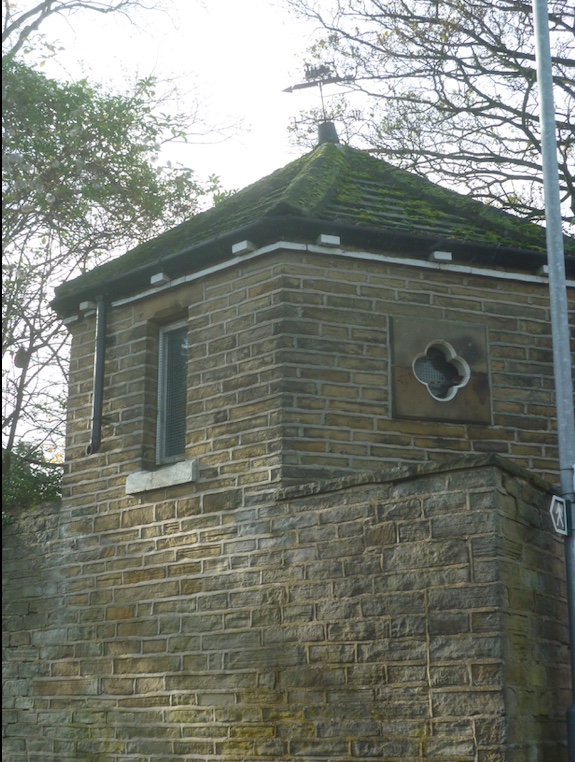
At the corner of the Highbury House garden, look up to see the ornamental weather vane (above right pic.) then turn to the right onto a wide path (pictured below). Follow this path across Shannon Road onto the track which brings you to Back Braid.
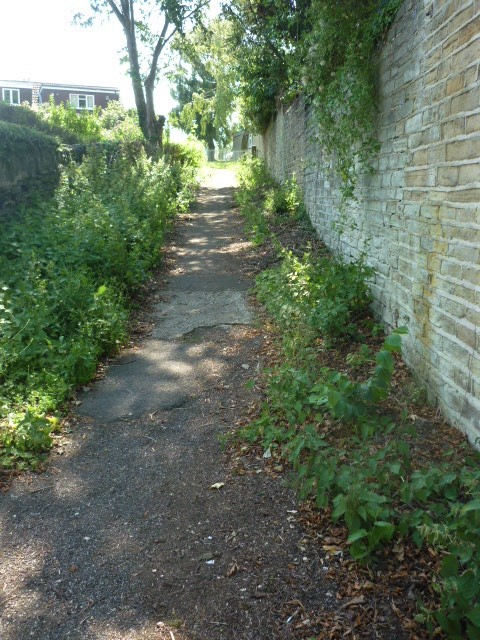
However, from November 2020, for at least six months, the path between Shannon Road and Back Braid will be closed for building work so if people are thinking of actually walking this route they will have to head down Lower Edge Road to the the junction with Delf Hill.
By taking this route, it does give the advantage of viewing the ancient milestone on the traffic island at the junction with Delf Hill. It is dated 1787, a time when townships were obliged to place markers at important road junctions. Not so long ago, this island contained houses, replaced by a flower bed, now just grass.
Go down Delf Hill but then turn right up the footpath to get you back to Croft Hollow and Spout Hill but unfortunately, this means missing out on Back Braid and Mount Pleasant.

However, the armchair walkers can remain on the ‘Virtual Route’ via the closed footpath. The walk leads onto Mount Lane and along to Back Braid. There have been various spellings such as Back Braid or Back Brade on modern maps, whilst Back Bread is the name given on the township map of 1824 and the OS maps of 1854 and 1893. The 1905 revision though, has it as Back Braid. The area currently consists of several houses (shown below) and a nearby collection of dilapidated farm buildings. Most of it will be demolished when a planned housing estate is constructed.
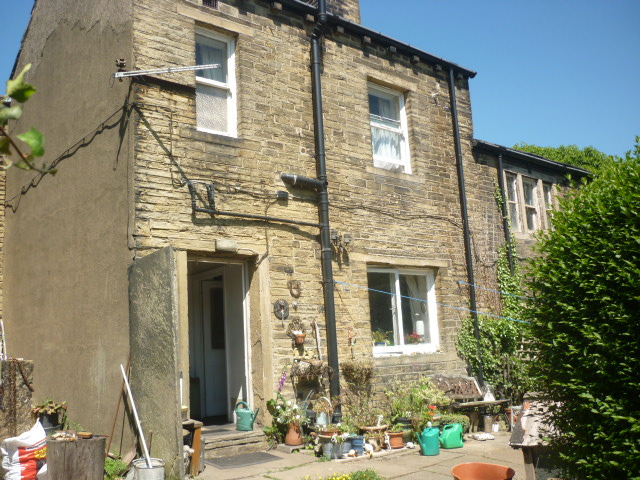
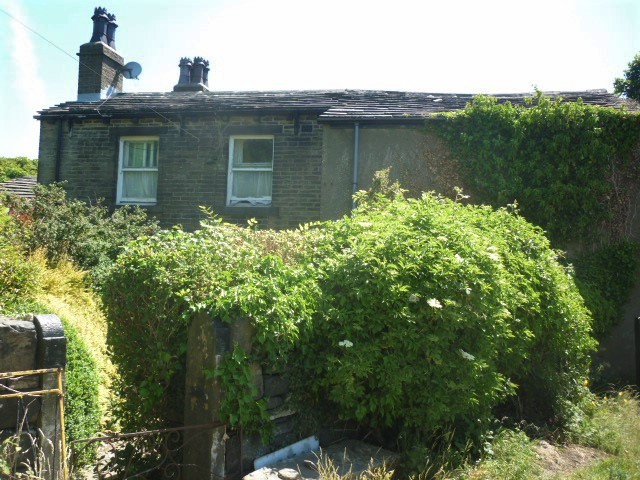
Remain on the track past the houses and when approaching the farm buildings there is a stile in the wall to the left (bottom left photo). Through the stile is a path which takes you across the field to a further stile (bottom right photo). Turn left onto the continuation of Mount Lane and on the right is a row of houses known as Mount Pleasant.
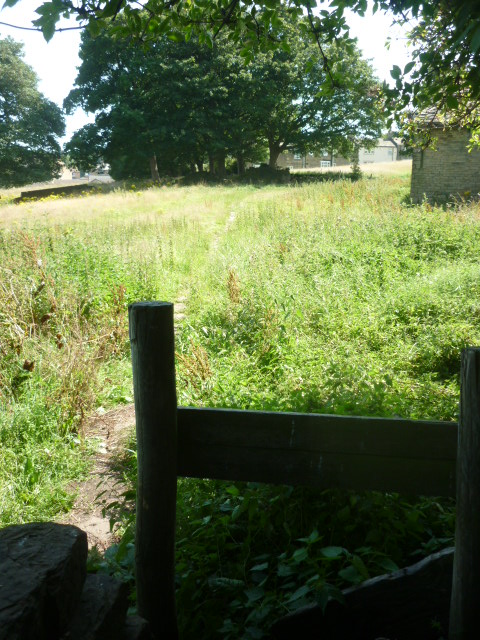
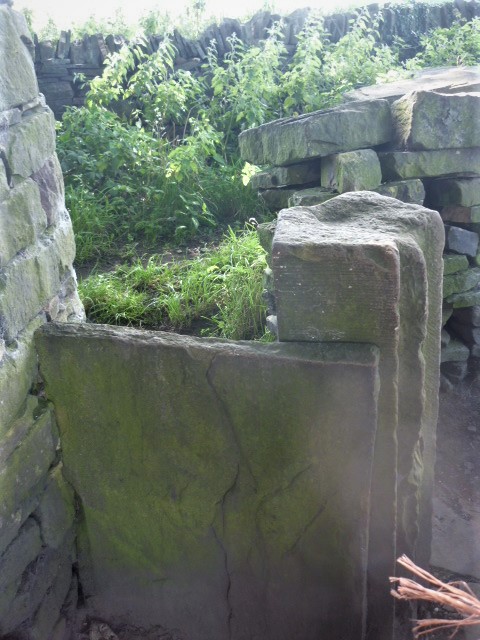
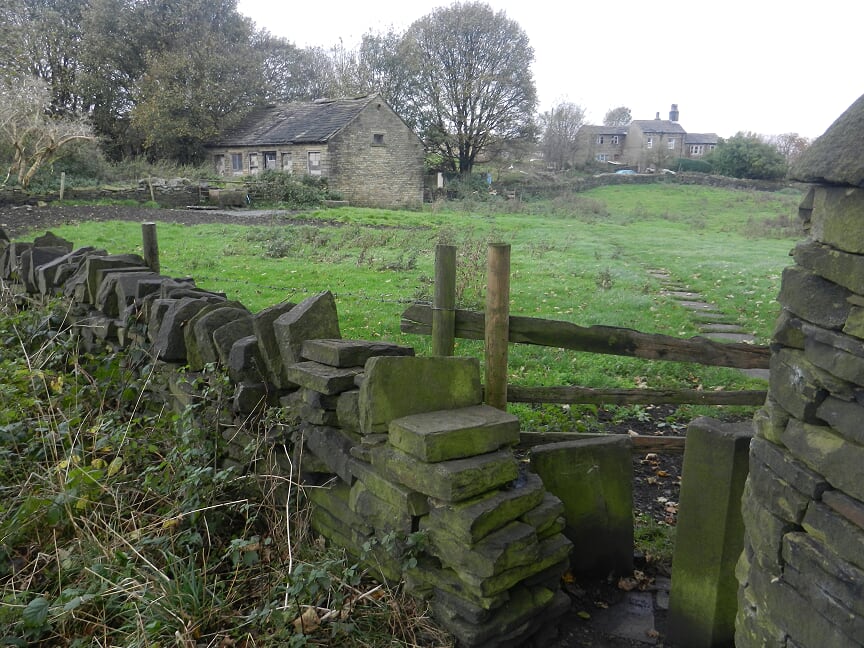
On your left used to be a fine ancient barn but that was destroyed some years ago, before the former mill buildings were replaced by the modern flats on either side of the track. The area below Mount Pleasant was known as Croft Hollow and at the bottom of Mount Lane is Spout Hill. Here at Croft Hollow and Spout were mills and houses, now all gone. They owed their siting to the Rastrick Beck which runs underground at this point and cannot now be seen or heard but before the redevelopment was obvious from the noise it made as it passed under the mill it once powered.
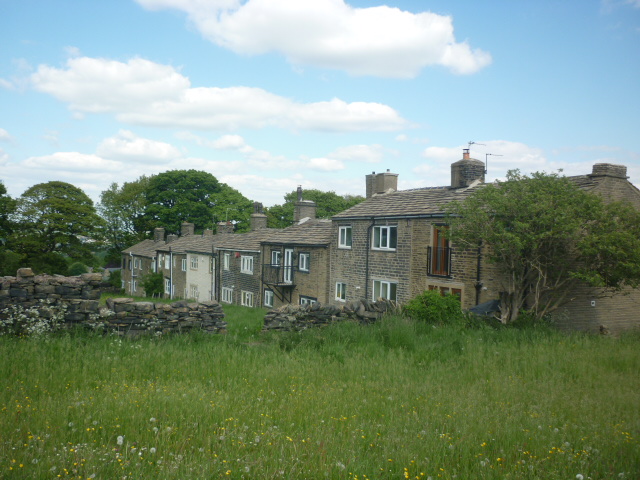
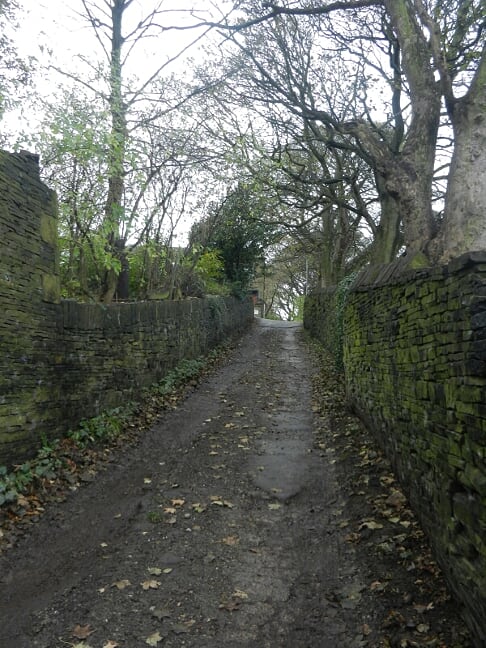
At the Great Exhibition of 1851, exhibitors in the Woollen and Worsted section included Jonathan Schofield, Rastrick, who exhibited:
Fancy woollen trouserings;
Silk, woollen and cotton waistcoatings;
Cashmeres, all wool;
Fancy bed furniture in wool, silk, cotton;
Fancy dresses and shawls.
In February 1852 there was offered for sale by auction ‘all that substantial messuage or dwelling house, with the barn, stable and mistal, called or known by the name of New Hall Riding or Spout. And also the dryinghouses, dyehouse, warehouse and buildings thereto belonging. Together with all those four several closes or parcels of excellent land therewith occupied, called or commonly known by the several names of Back Door Close, the North Field, the Upper Ing and the Lower Ing, containing together by estimation nine days’ work, be the same more or less, all now in the occupation of Mr Jonathan Schofield, the owner, or his under-tenants…. The buildings on the estate are modern, well constructed and in excellent repair, and are well adapted for manufacturing or dying purposes.’
In August 1853 Jonathan Schofield sold by auction ‘a large quantity of fancy weavers implements &c on account of discontinuing some part of his business’.
He did not give that up completely as is evidenced by a reported burglary at his works in December 1854. In August 1860 he advertised to be sold or let at Oaks Green, ‘good substantial buildings in excellent condition part of which had been recently erected, well adapted for a fancy woollen manufacturer, having been used for that purpose for more than fifty years’. The whole comprised ‘five large rooms with chambers over, two large warehouses, press shop, five stall stable, coach house, cart sheds, two large gardens, and land with never failing spring of water, owned and occupied by himself.’
This was offered again in September, this time by auction, with the explanation that Jonathan Schofield was ‘declining in business.’
The following August there was yet another notice of goods and equipment for auction and premises for sale. Again, he did not give up entirely, for in 1862 it was reported that his mill had lead stolen from the roof.
In July 1863, ‘a dwelling house, outbuildings and a warehouse and premises, 3100 square yards in total, occupied by Mr Jonathan Schofield and situate at Oaks Green,’ were offered for sale. In October he offered for sale, in working order , twenty-eight yards of double stove tenters, ‘the room being wanted for another purpose’.
In the 1861 census Thomas Helm is described as a fancy woollen manufacturer, and William, his father, as a fancy woollen manufacturer employing one hundred and eighty hands. In 1870 Thomas Helm established the firm of Thomas Helm and Sons at Spout Mill, spinning and scribbling mills. The mill had been built by Thomas, his brother, John, and his father, William, in 1850. Whether or not this was the same mill offered for sale by Jonathan Schofield in 1852 is unclear – given the history of Mr Schofield’s sales, it seems more likely to have been an adjoining property. Certainly William Helm was manufacturing in Rastrick in 1852, for in April he was the defendant in a court case when he had refused to pay for yarn of unsatisfactory quality. Thos. Helm & Sons Ltd. remained in the family and was apparently still a thriving concern in the 1950’s, receiving planning permission for a further extension to Spout Mills in September 1952. However, the firm closed in the 1960’s.
After the demise of Helm’s, the mills were used by several small businesses, one of these being Cellofoam, part of Lord Kagan’s textile empire. A three-storey building full of carpets was destroyed by fire in 2001 and had to be demolished. The remaining buildings were demolished in autumn 2005 and the present flats built the following year.
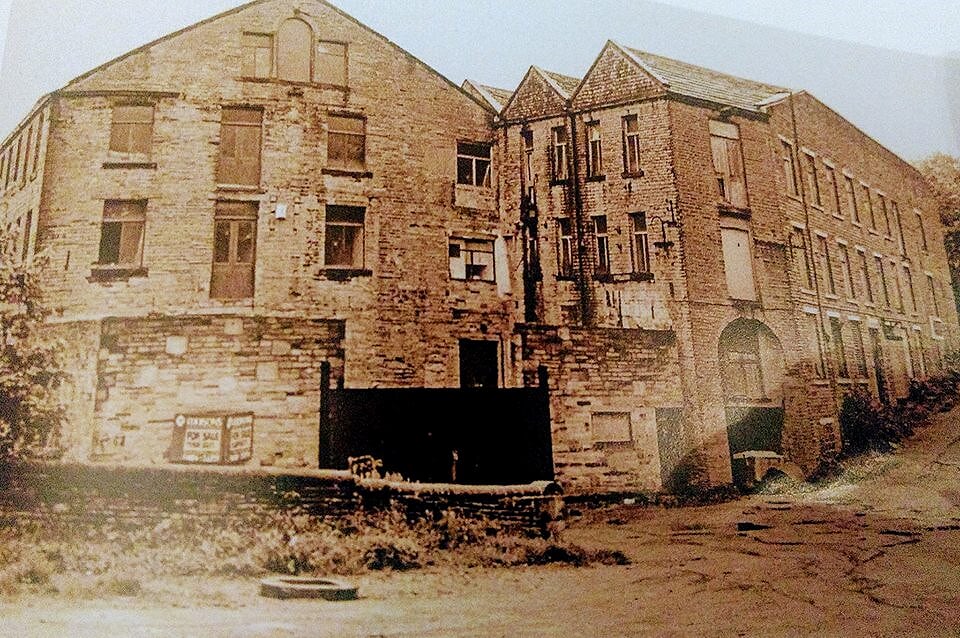
The former Spout Mills site is now populated with modern houses and apartments. From Croft Hollow, turn left onto Spout Hill where the road passes Sage Grove before reaching the top of the hill at its junction with New Hey Road. On the left in the twentieth century was a wooden hut selling greengroceries and on the right, for some years in the 1970’s and ‘80’s, a Volkswagen parts suppliers. This also involved some vehicles languishing for long periods in a state of disrepair which was annoying to some residents.
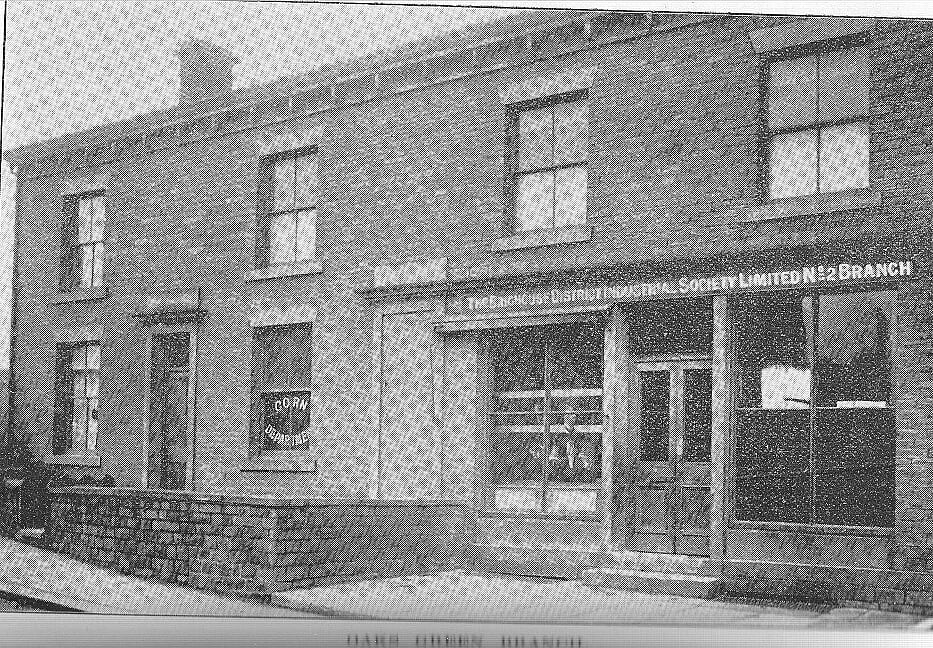
The corner house on the left at the top of the hill was the Co-op manager’s house attached to the Oaks Green branch of Brighouse Co-operative Society. The Co-op had been doing so well in Rastrick that in March 1864 that, ‘it was decided to buy from John Crossland, a plot of land at Oaks Green with frontage to New Road’. On this land would be built ‘a new store and two cottages’. There was some dispute with the Rastrick Local Board regarding the building line but a compromise was reached. Tenders for the work were submitted in June and after some discussion about costs, accepted in August that same year. In the 1970’s the Co-op closed many of its branches, including that at Oaks Green. Subsequently the premises have been occupied by a carpet shop and, most recently, a milliner’s.
Straight ahead, on New Hey Road is what is now called Apex House, and behind that, beside Greenhead Lane, premises which in recent years have gone by such names as the Spitfire and the RAFA Club but which at the start of the twentieth century were the home of the South Ward Liberal Club.
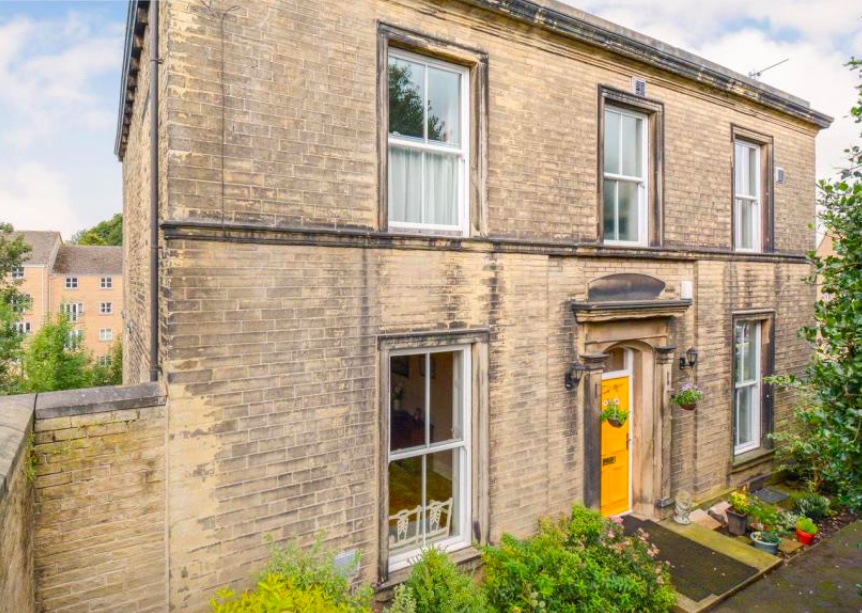
Turn right to go up New Hey Road. The large house on your right is Croft House, built about 1850, though it is not marked on the 1854 map which was surveyed 1848-50. It was until 1964 the home of the mill-owning Helm family. The house was then divided into flats with a succession of short stay residents and became rather run down. In 1972 permission was given for it to become a hotel but this never happened. Eventually, it was sold and restored over the winter 2010-11 to its original form of ‘a smart gentleman’s residence.’ Part of the garden has been sold for building.
Across the road a large house has its back to the road. It is not the only example in the area. It has to be borne in mind that the road itself at this point is of comparatively recent origin – the 1800’s – so some buildings predate it.
Next on the east side of the road is what now officially goes under the name of New Road Independent Family Church but is much better known as New Road Sunday School. This was founded in 1837 and has been extended on several occasions since then. Through the nineteenth and twentieth centuries the Sunday School was the centre of local social life. Until the opening of Carr Green School in 1912, New Road was the local day school. During the second world war it housed a British Restaurant. Famed until recently for its cricket and billiards teams, in the past it ran many other sports, entered a float for the annual Brighouse gala, often winning a high prize, and mounted several public concerts each year. For much more information refer to the New Road Sunday School section on this website where Andrew Eccles’s 2012 book, The History of New Road Sunday School, Rastrick is available to read online.
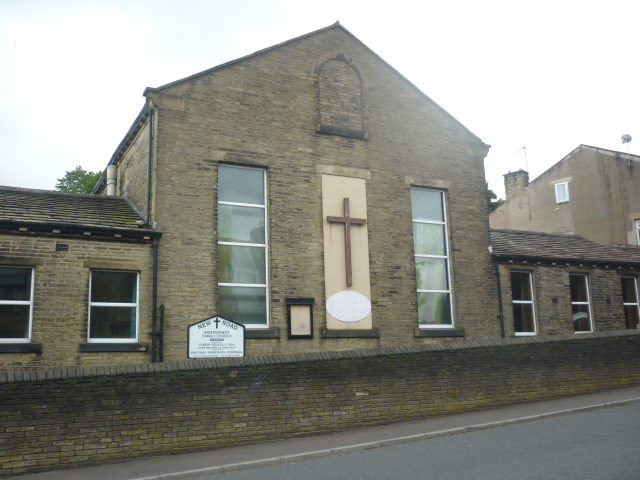
Immediately above the church is the last locally remaining block of back-to-back houses. The fronts have addresses on New Hey Road and the backs are on New Road Square. Perhaps surprisingly, these were not condemned at the same time as New Road Mount, which was on the spare ground on the right, or Denham Square, Walker Square and New Road Fold further up and, across the road, Providence Place, Regent Place and Sayles Row. Those were all subject of The Borough of Brighouse (New Hey Road no.1) Clearance Order 1959, which came into operation on 19th February 1960.
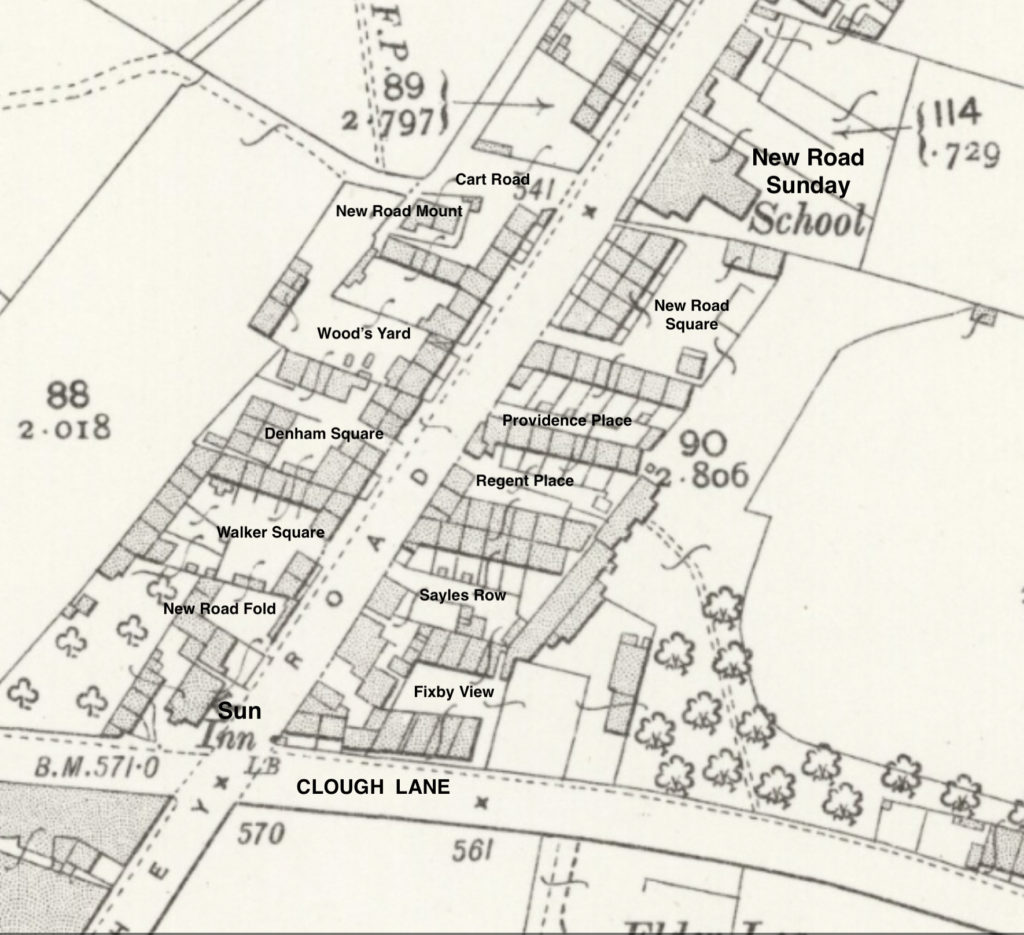
The site of those last three is now occupied by four blocks of four flats, intended for occupation by older people. They were built in 1967 and named Regent Close, pictured below.
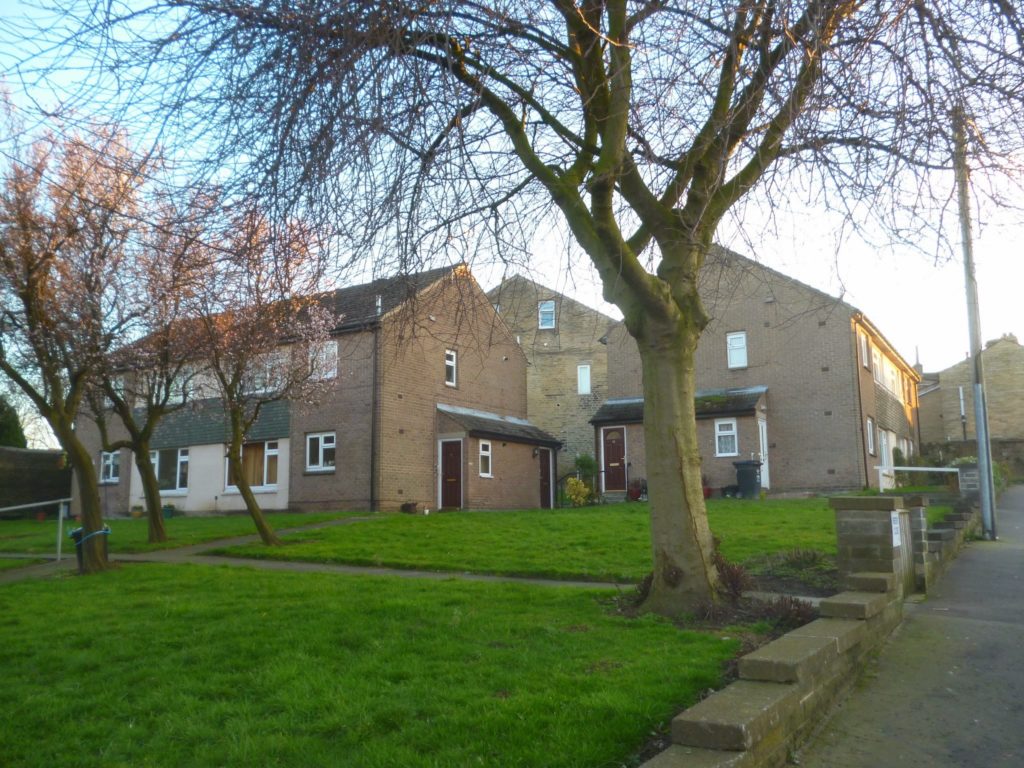
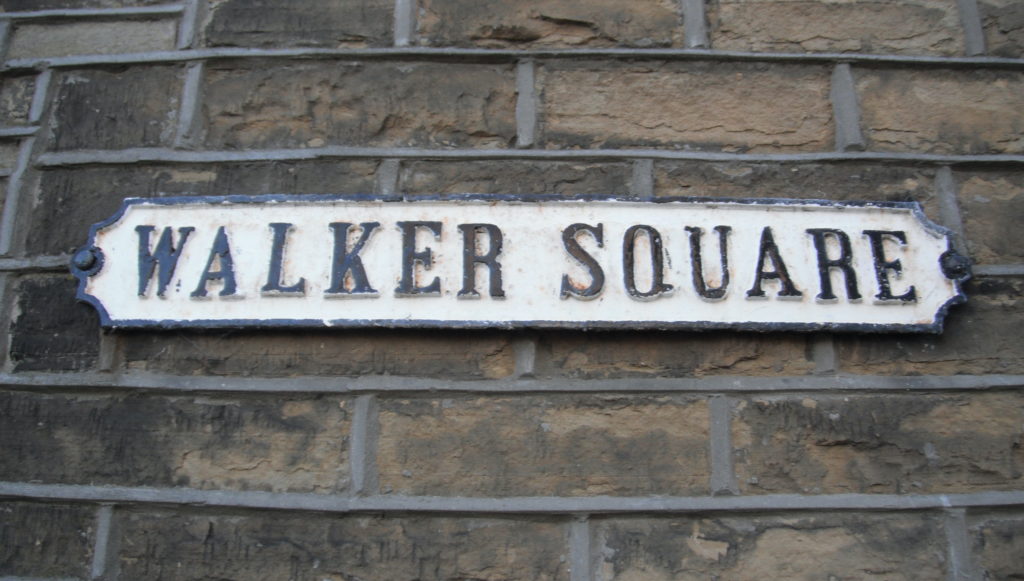
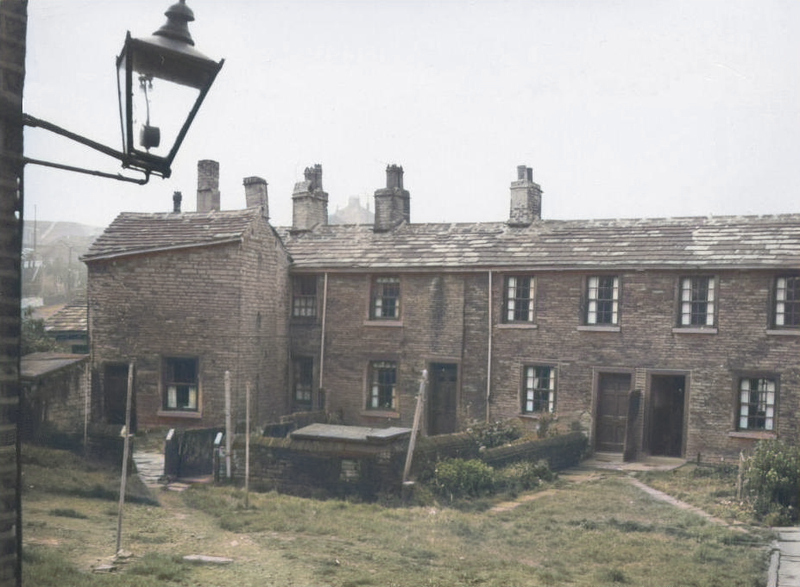
On the right above the entrance to Walker Square is a house, now numbered 90 – 92, which was formerly a house and grocers shop. Outside the shop was the tram stop, later trolley bus and now bus stop. On the photograph below, you can make out the name of Shaw on the board above the door. The photo is dated 1905 when Sarah Jane Shaw, a spinster, along with her niece, Sarah Margaret Whiteley, ran the shop. Sarah Jane’s parents, Matthias and Elizabeth Shaw had owned the shop from at least the 1860’s and possibly from when it was built as he lived at New Road all his life, having been born in 1808. He worked from there as a cordwainer (shoemaker) and grocer.
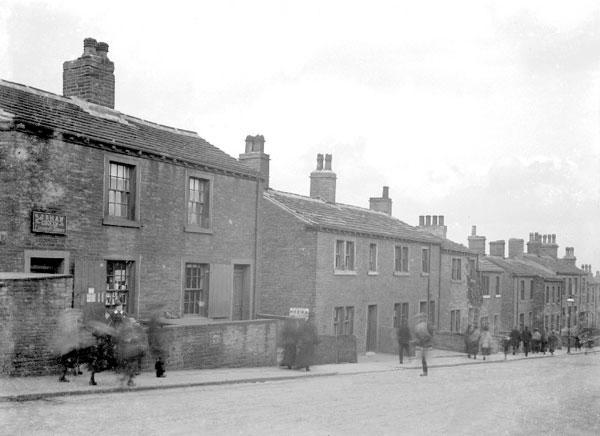
Across the road from 90 – 92 is what is now a take-away-food shop with attached house. Until the 1904 Licensing Act took effect this was a beer-house known as the Black Horse. This was another building which originally had no door onto the road. We know it was already a beer house in 1852 when John Pearson ‘late of the Black Horse Inn, Rastrick’ died. By 1871 one of the Bottomley families held the licence and over the generations, they were there for at least forty-one years.
When the licence was challenged in 1912, Whitaker & Co., who owned the house, objected on the grounds that it had been in operation for over seventy years without a single complaint and that if it were closed a rival company, Ramsden’s, would have a monopoly in the area. Nevertheless, it was closed the following year. A door was inserted in the New Road frontage and for many years there was a fish and chip shop here, known as the New Road Fisheries and later, Black Horse Fisheries. More recently, with enlarged door and windows and under a succesion of names, it has served south-east Asian style food.
Look at the building behind the shop and note its enormity. Towering over the surrounding houses and with an unusually large overhang at the eaves, this is the end gable of Fixby View Yard and its Clough Lane frontage. Here was a woollen mill, marked as such on the 1854 map. A plan, submitted by one John Taylor, to convert these blocks into four dwelling-houses and four ‘cottages’ was approved on the 3rd June 1891.
Also across the road, note the blocked doorways of what were originally two houses, now numbered 79 – 81. At least as early as the 1861 census there was a grocer’s shop here. By 1910 the two premises had been combined as a house and shop – despite there being a similar establishment directly across the road. Post-war it was a hairdresser, cigarette and sweet shop. From 1959 to ’69 Evelyn and Jimmy Dawson sold sweets and greetings cards but when they left it soon closed as a shop.
To the right, the modern house is appropriately named “The Fold”, standing as it does on the site of New Road Fold, which was demolished with the other squares in the 1960’s.
We are back where we started at the Sun Inn crossroads. The walk ends here and if you have actually walked the route, you can decide whether to partake of refreshments.
